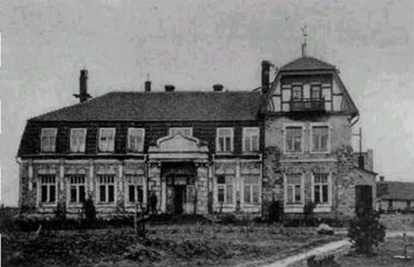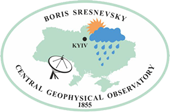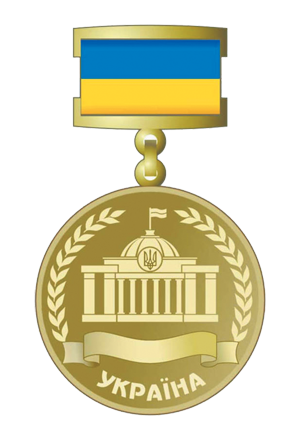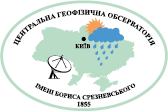A Mironivka

08853, Obukhiv district, Myronivka united territorial community,
Tsentralne village, 30 Tsentralna str., tel. (04574) 7 41 97
| Facebook page of the station: facebook.com/asmyronivka |

The history of the Myronivka agrometeorological station
Myronivka Agrometeorological Station is located in the southeast of Myronivka district near the picturesque village of Tsentralne, which is geographically located in the watershed of the Dnipro, Ros, and Rosava rivers.
In May 1913, sugar producers established the meteorological department of the Central Experimental Breeding Station in Myronivka.
From the archival records kept at the Myronivka V.M. Remeslo Wheat Institute: “The main activity on meteorological issues was taken over by Oleksii Konstantinovych Filipovskyi. An observation house was set up in the park near the station for observations. The supervision was carried out by Yovenko. On May 1, 1913, constant observations began. “ From the book “Varietal Stations of the Sugar Trust” (1922-1923, pp. 44-65):
“In addition to purely research work, meteorological work is also carried out. There is a meteorological installation that draws conclusions about the climatic characteristics of this point. The station was equipped with recorders.”
All meteorological observations at that time were conducted on a four-line cycle. To improve the observations, recorders were used, devices that recorded (on special tapes) the temperature and humidity around the clock, and they were installed in a meteorological booth at the meteorological site. A rain gauge was also installed here, which measured the amount of precipitation twice a day. There was also a pressure recorder that stood in a room on the third floor of the chemical laboratory, where the meteorological department was located.
(see photo of the Chemical Laboratory and the Meteorological Department).
 |
| Chemical Laboratory and Meteorological Department |
A weather vane was installed on the roof of the same building to monitor the wind direction and speed.
“Since 1913, meteorological observations have been carried out, which made it possible to characterize the climatic conditions of the Myronivka Experimental Breeding Station and compare them with those of other beet-producing areas from Podolia to the eastern part of the Voronezh province.”
In 1921, based on the observations of the meteorological department of the Central Experimental Breeding Station in Myronivka, the Myronivka meteorological station was established, which remained a subordinate breeding station but was already part of the Hydrometeorological Service network. It is unknown who was the head of the station from 1921 to 1930. From 1930 to 1941, the station was headed by a specialist in agricultural meteorology, senior researcher Malish M.V., and the worker was Zahika O.M. (photo of the meteorological site with the supervisor).
The meteorological station was of the 2nd category of the 1st class. In this status, meteorological observations continued until the beginning of World War II.
After the war, the work of the meteorological station resumed, although, according to eyewitnesses, meteorological observations were carried out during the occupation regime, but, unfortunately, the observation materials have not been preserved.
In 1944, after the territory of the breeding station was liberated from the Nazis, a new revival of the meteorological station began under the leadership of Tiutiunnyk (she was a woman, but her name and patronymic are unknown), who worked for a very short time. In January 1945, I.S. Zakharov became the head of the station. The station is gradually revived - new instruments and observations are introduced. The range of crop observations was expanded. In 1946, the station was granted the status of agrometeorological. Since then, the station has been fully transferred to the Hydrometeorological Service, but close ties with the breeding station have not ceased. Joint scientific work is underway. The management of the breeding station provides assistance in solving production issues. But in April 1947, the head of the station was changed - the station was headed by S. Sukailo. The question of the station's development arose - allocation of land for a meteorological site and construction of the station's premises. New positions are introduced: senior agrometeorologist and agrometeorologist. The scientific and thematic work is expanded.
In 1948, on the outskirts of the experimental breeding station in Myronivka village, a plot of land (1.0 hectares) was officially allocated for the construction of an agrometeorological station. On August 24, the weather station was moved from the park to the field.
In May 1949, the Myronivka Agrometeorological Station was renamed the Starchenko Agrometeorological Station (and it was called that way until 1980, when it was called the Myronivka Agrometeorological Station) and in September Tatarinov was appointed to the position of head. The basic principle of agrometeorological observations is to conduct observations of the state and change of agrometeorological factors in parallel in time and space, as well as changes in the development, growth and condition of crops and in the formation of elements of their productivity and final products.
In March 1954, after A.Y. Friedrich, Director of the Breeding Experimental Station, and T.K. Bohatyr, Head of the Hydrometeorological Service, N.M. Khidko was appointed Head of the Station, and she worked fruitfully until her retirement in 1970. Under her leadership, together with scientists of the research station, scientific work was carried out to determine the critical freezing temperatures of winter crops. The range of meteorological and agrometeorological observations was significantly expanded and actinometric observations (sun observations) were introduced. On January 1, 1966, all meteorological observations were switched to eight-day observations. Many pages of the station are associated with the name of Nadiia Mykolaivna, a person of outstanding organizational skills and a good hostess. She was responsible for the entire construction of a residential building for the staff, working and utility rooms, which were built in 1955-1956. The construction was carried out at the expense of the state hydrometeorological service and with the considerable assistance of the breeding station. (photo - new weather station and premises, 1968)
The staff of the station, under the leadership of the chief, beautifully cultivated the territory of the station, planted ornamental and fruit trees that still delight people today. Nadiia Mykolaivna is a wise, kind mentor who has trained many generations of agrometeorologists. Even after retirement, she returned to work from time to time to provide all the help she could. She managed to make the station the best not only in the Kyiv region, but also in Ukraine and the former USSR.
From 1970 to 1973, Anatolii Sukhovetskyi worked as the head of the station, and from 1973 to 1974, Zoya Shapovalova worked as the head of the station.
During these years, a large-scale development of the Myronivka Research Institute of Agricultural Sciences took place. The agrometeorological station was not neglected. The second stage of the revival of the agrometeorological station began in October 1974, when Maria Mykolaivna Koshchavka took over the management of the station. This energetic, creative, wise woman was the head of the station for 9 years and had a considerable amount of work on her shoulders, which she managed very well. During this time, the station's premises were rebuilt and completed, central heating was installed, and plumbing equipment was installed in the premises. New modern instruments and equipment were installed at the station. A device for measuring the lower boundary of clouds and an anemorumbometer were installed, replacing the weather vane. These devices have greatly facilitated meteorological observations and improved their quality. Radiometric observations of the natural radiation background were introduced and are still carried out regularly. So, when the Chornobyl accident happened on April 26, the station was the first in the area to record high radiation levels. Mariia Mykolaivna created the Agrometeorological Bulletin of Long-term Data for the Myronivskyi District, which has been indispensable in the work for a long time. The station became a solid base for internships for university and college students from all over the USSR. Maria Mykolayivna's work was highly appreciated by the leadership of the Hydrometeorological Service. Every year, the station's staff was awarded diplomas of the USSR and USSR Hydrometeorological Service.

The team has been repeatedly awarded diplomas of the State Hydrometeorological Service, the Borys Sreznevsky Central Geophysical Observatory for its diligent work and has repeatedly won the honorary title of the best station in Kyiv region. I would like to say a kind word to the veterans of the meteorological service, M.Y. Ostapenko, L.V. Dubrova, and L.M. Kovalska, who have worked all their adult lives at the agrometeorological station and made a significant contribution to its development, and are now on a well-deserved rest. A kind word should be said about the unfortunately deceased Vira Demydivna Novitska, who worked as a meteorological technician from 1972 to 2008.
Currently, the Myronivka Agrometeorological Station conducts meteorological observations of visibility, cloud cover, atmospheric phenomena, air and soil temperature, humidity, and atmospheric pressure. In winter, observations are made of ice and frost phenomena and snow cover. Agrometeorological observations of crops are carried out for crops sown in the fields of the Myronivka Wheat Institute named after V.M. Remeslo, SE DG “ELITA” and PJSC SPF “UROZHAY” in Myronivka. Myronivka.
The station has been storing and replenishing stock material since 1945, on the basis of which the station's agrometeorologists make excellent agrometeorological forecasts: reserves of productive moisture in the soil at the beginning of the growing season, flowering of fruit trees, flowering of grasses, timing of buckwheat sowing, agrometeorological conditions for the development of crops. Such forecasts help agricultural producers sow, harvest and preserve crops on time.
Today's work is impossible to imagine without computer technology. The first PC at the station appeared in 1999. Now the station has a barometer - BAR (electronic pressure gauge), and the ARM METEO program has been implemented, which provides online transmission of meteorological information. Electronic versions of TSG-1, TSG-6, TM-9 and complex meteorological data charts have been created and are successfully used.
The station cooperates with scientists of the Myronivka V.M. Remeslo Wheat Institute, district and local authorities, agricultural producers in providing agrometeorological information and warnings about natural hazards. The head of the station is a member of the district commission on industrial safety and emergencies. The service area of the Myronivka Agrometeorological Station includes not only Myronivka district, but also Kaharlyk, Bohuslav, Tarashchanka, and Rokytnyansky districts.
The tireless work of the station's employees (at all stages of history) and their fruitful work has been repeatedly recognized with diplomas and awards not only in Kyiv region, Ukraine, but also in other countries. The station is part of the international observation system. The meteorological observations of the Myronivka Agrometeorological Station are used by weather forecasters in America and Europe to make weather forecasts. They highly appreciate the quality of observations. All the heads of the Myronivka agrometeorological station made a significant contribution to the achievement of high performance. Each of them was experienced, responsible, and purposeful.
Today, I would like to express my gratitude and bow low to people of all generations whose work over the centuries has created a solid foundation for further improvement of work and working conditions.







